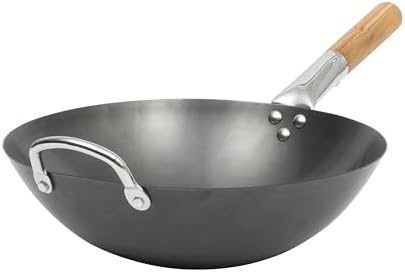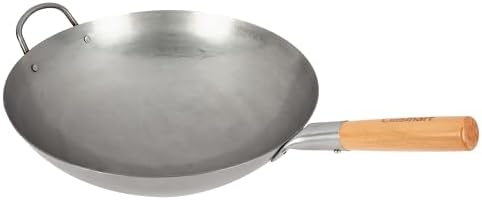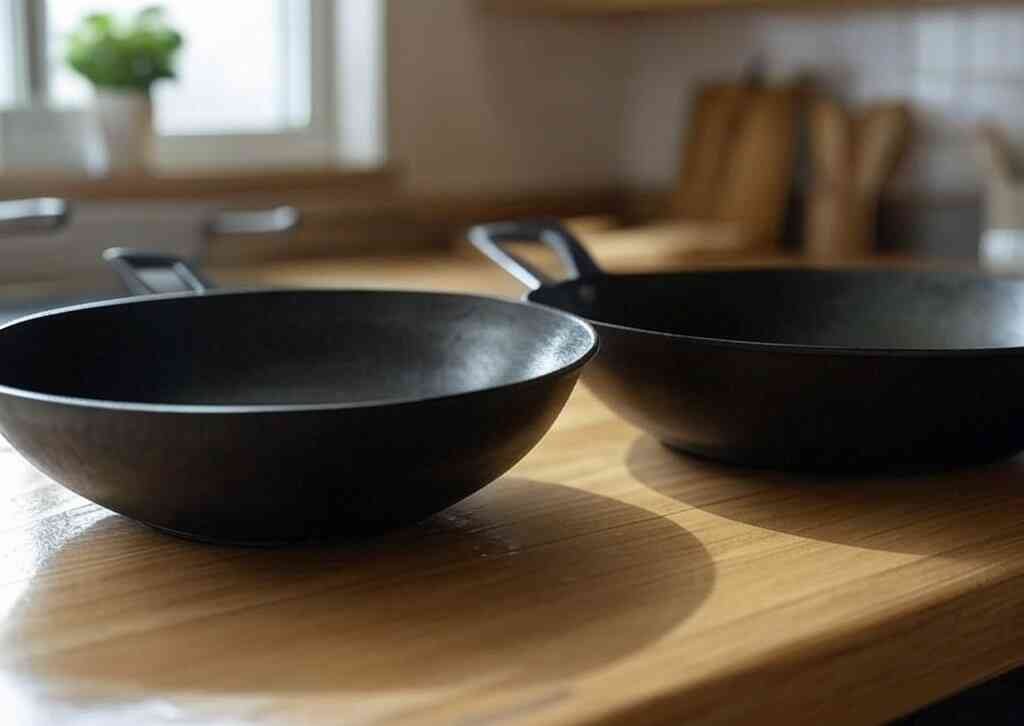Learning Carbon Steel Woks
Carbon steel woks are a favorite of food aficionados due to their unique characteristics that foster cooking practices. In contrast to other materials used in cookware such as stainless steel or cast iron, carbon steel boasts unmatched heat retention and circulation. When heated adequately, carbon steel woks can achieve extreme temperatures quickly, making them ideal for stir-frying. The sensitive thermal response enables cooks to yield precise results, particularly when carrying out practices such as searing or browning.
The efficiency of the material at conducting heat ensures the food cooks evenly. Reducing the instances of hot or cold spots in cooked food. This is particularly notable with food that needs to be cooked fast, such as in traditional stir-frying. The effect is that food has a fine balance of taste and texture. Extracting the full culinary worth of this handy utensil.
Seasoning is the most crucial aspect of maximizing the efficiency of a carbon steel wok. Carbon steel is not shipped pre-seasoned, as non-stick pans are. And therefore needs to be seasoned in order to produce a naturally non-stick surface. Oil is applied to the wok, and it’s then heated, polymerizing the oil to form a layer. Not only does this prevent food from sticking, but also accumulates a depth of developed flavor with use. Regular maintenance, including proper cleaning and drying processes. Must be done to prolong the life of the wok and preserve its culinary capability.
Ultimately, having a knowledge of the unique traits of carbon steel woks can greatly impact cooking processes and recipe adaptation. Understanding the material’s heat conduction, reactivity, and requirement for seasoning. Amateur cooks can use these strengths to achieve the best results for their cooking activities.
Changing Cooking Methods
When cooking with a carbon steel wok, it is essential to adjust your cooking techniques to achieve the best possible results. One fundamental adjustment is preheating the wok. Unlike traditional pans, carbon steel woks require thorough preheating to enhance their non-stick properties and to ensure even cooking. To preheat effectively, place the wok on medium-high heat until it is hot enough that a few drops of water can dance around the surface. This is the most important step that becomes the foundation of a successful stir-frying.
Secondly, high heat is also needed in stir-frying due to the quick method of cooking inherent in this process. Carbon steel woks heat very well, making it possible to cook food quickly and retain the flavors as well as the food’s moisture. Unlike non-stick pans that can be destroyed by excessive heat, carbon steel can thrive under such conditions. When stir-frying vegetables or proteins, for instance, look for heat that creates a mild smoke, which indicates that it is searing. This quantity of heat will alter the taste and texture of your food, and make it more appealing.
The control of heat aside, the application of oils also plays a role in cooking with a carbon steel wok. The oils should be of a high smoke point type, such as grapeseed, peanut, or canola oil. These oils are able to withstand the hot heat necessary for good stir-frying and also prevent the wok from sticking. Furthermore, cooking lengths and techniques need to be modified for some ingredients that will behave differently in the wok than they would in other frying pans. Leafy greens, for instance, need to be added towards the end of the cooking process in order to preserve their texture and color. By achieving these subtleties and applying the correct adjustments, the taste and texture of food cooked in a carbon steel wok can be significantly enhanced.
Learning to Accommodate Ingredient Selection
Ingredient selection is a key consideration when cooking with a carbon steel wok in order to achieve best results. Since it possesses better heat retention and distribution properties. The carbon steel wok is particularly ideal for high-heat cookeries like stir-frying. Such that the food items chosen should complement this form of cookery. To a large extent, light meats like chicken, shrimp, and pork are the best choices because they can be prepared in a few minutes with high heat without losing moisture and tenderness. For meat lovers, thinly sliced pieces such as sirloin or flank will be the best option.
Vegetables are a vital ingredient as well; they need to be selected not only for flavor but also for texture. Vegetables that can be prepared quickly, like bell peppers, snap peas, and broccoli florets, are ideal, as they do not lose their crunch when subjected to high heat. Slicing vegetables of the same size is useful, ensuring uniform cooking time. For instance, slicing carrots into thin matchsticks or onion into tiny squares will ensure they cook quickly and uniformly.
Aromatics such as garlic, ginger, and scallions must be added with caution. Because they are so strong, it is important to add them towards the end of cooking time to avoid burning and to ensure that their flavor contribution is maximized. Also, marinating your ingredients prior to cooking will add a lot to their taste profile when cooked with a carbon steel wok. A simple marinade of soy sauce, sesame oil, and cornstarch can tenderize meats and act as a tasty coating that adheres well through the cooking process.
Finally, understanding how to adapt ingredient choices not only results in more flavor but also assures that the unique merits of a carbon steel wok are optimized, allowing home cooks to adapt their recipes for spectacular outcomes.
Recipe Adjustments and Tips
When porting recipes to your carbon steel wok, some adjustments may be made to ensure the best outcomes. The unique nature of a carbon steel wok, which can retain high heat and radiate it evenly, calls for adjustments mainly in proportions of ingredients, seasoning, and cooking sequence.
For classic stir-fries, begin by reducing the quantity of meat or protein; a lesser amount cooks more evenly and allows for proper browning. Aim for thin, evenly cut pieces, as they will sear quickly in the hot surface of your wok. Moreover, make sure to have all your ingredients prepped and close at hand. This is key, as the quick cooking time that is associated with wok cooking means that you will need to work quickly in order to achieve the desired texture and flavor.
With fried rice, a standard in wok cooking, day-old rice is ideal. It reduces moisture content and prevents clumping. When seasoning, add more soy sauce than other sauces so the flavor permeates throughout without overpowering the dish. Add a sprinkle of sesame oil during the final moments of cooking to enhance flavor and body.
With sautés, the water content of your vegetables is a large factor. Be careful adding water-rich vegetables like zucchini or bell peppers; they will significantly reduce heat if added too early in the process. Start with denser veggies like carrots or broccoli, and then add others like snow peas or leafy greens towards the end of the sautéing time.
Besides these changes for familiar recipes.Consider how versatile a carbon steel wok is to use when trying out world cuisines. From Thai to Chinese to Vietnamese cuisine, replicating flavors and techniques can be delicious. Test by replacing traditional ingredients with fresh herbs or spices that blend with the flavor profiles of your target cuisine. Thereby encouraging creativity and innovation in your cooking.












[…] item in every kitchen. Whether you’re preparing a quick dinner or having guests around, a carbon steel wok will suffice. And, if taken care of, they last decades. A seasoned wok only gets better with time […]
[…] right care and maintenance of a carbon steel wok are critical in maintaining its functionality and longevity. Re-seasoning and cleaning schedules […]